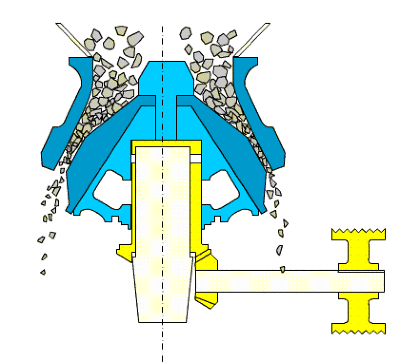Multi-cylinder hydraulic cone crusher has the characteristics of large production capacity, large crushing ratio, good product shape, low energy consumption, high degree of automation, high reliability, simple operation and maintenance, and low cost of use. It can be widely used in the medium and fine crushing operations in metallurgy, mining, aggregates, cement and other industries, and crushing non-ferrous and ferrous metal ore such as river pebble, granite, basalt, limestone, dolomite, etc. The multi-cylinder hydraulic cone crusher can efficiently crush high-hardness raw materials and has become the favored choice of most sand factories, and its position in the sand and gravel industry is getting higher and higher. The cone crusher can crush high-hardness raw materials in medium and fine, and the finished product has a good grain shape. The crushing cavity shape can be changed from standard ultra-coarse cavity to short-head ultra-fine cavity. It can adapt to different product particle size requirements.
What is the difference between the standard type and the short head type?
1. The shape of the crushing cavity is different. The parallel belt of the short head type cone crusher is shorter than the long standard type.
2. The granularity of crushed products is different. The short-head cone crusher with a relatively long parallel belt, the crushed material is relatively fine, and this type of cone crusher is generally used after being crushed; while the standard cone crusher has a coarser grain size of the crushed material and the output high, the crushed material can be used for medium crushing.
3. The width of the discharge opening is different. Compared with the short-head cone crusher, the standard cone crusher has a wider application range of discharge opening, so the standard cone crusher has a larger processing capacity in terms of unit time.
Standard type is used for two-stage crushing and three-stage crushing. The particle size of the finished product is generally greater than 14mm. The short head type is used for three-stage breaking, and the particle size of the finished product is less than 13mm. The tight side feed port of the multi-cylinder hydraulic cone crusher cannot be smaller than the larger feed size. The feed inlet cannot be too large or too small.
If the material inlet is too large: ①Materials are mainly concentrated in the lower part of the crushing chamber, causing excessive wear of the lower part of the liner and low utilization of the liner. ②The crushing ratio decreases, the crushing efficiency is low and the moving cone rotates easily.
If the inlet is too small: ①Materials cannot enter the crushing chamber, the production capacity is severely reduced, and the inlet lining is severely worn or even destroyed. ②Causes a large fluctuation of the crushing force and the jump of the adjustment ring, which causes damage to the frame seat gasket, accelerates the wear of the locking cylinder seal, and affects the stability of the equipment.




